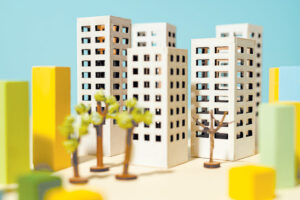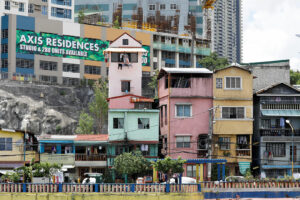Condos are redefining modern living, becoming the new favorite among Filipinos living in the urban jungles of Metro Manila. Much of the reason can be attributed to the rise of mixed-use developments that offer a balanced lifestyle of live, work, and play that is well-suited to the demands of daily life today.
As urban centers grow more congested and land prices soar, developers are responding to the increasing demand for residential spaces that offer not just a place to live, but a lifestyle. This trend is especially evident in major cities like Metro Manila, Cebu, and Davao, where high-rise condominiums are becoming a prominent feature of the skyline.
Leading real estate developers are developing condo projects within townships, providing a complete package of retail shops, hospitals, churches, and offices right near home. Moreover, these developers are elevating the game with resort-themed, smart homes, and eco-friendly buildings, offering high-quality living spaces in bustling cities.
According to professional services firm Colliers, an additional 9,620 new condominium units will complete construction in 2024, marking the largest completion in five years. Approximately two-thirds of these new units will be located in Metro Manila’s Bay Area.
“Given the delivery of sizable number of new condominium units in Metro Manila this year, Colliers encourages developers to continue offering attractive leasing promos especially for local employees that are returning to traditional office setup,” Colliers advised in their Property Market Report in February.
Interestingly, this has also been accompanied by an increase in interest for leisure condominiums outside the metro.
“An increasing number of Filipinos expressed a heightened interest in acquiring second homes, particularly in residential leisure condominiums in Metro Luzon,” property experts Santos Knight Frank wrote in their Philippine Real Estate Outlook for 2024.
“Tagaytay emerged as the favored location for second homes, with Pampanga and Batangas (Laiya and Nasugbu) tailing behind. In April 2023, San Juan, Batangas saw 689,000 domestic travelers, Nasugbu had 268,022, and Tagaytay welcomed 436,508 tourists. These figures emphasize thriving tourism and widespread appeal, but residential selling rates reveal more evident demand, with 42% of units sold in Metro Luzon classified under residential-leisure.”
Meanwhile, Pampanga leads in the Metro Luzon with a selling rate of P126,374/square meter (sq.m.), followed by Tagaytay at P122,500/sq.m. and Laguna at P117,269/sq.m. Bulacan, Cavite, and Laguna exhibit the lowest average unit prices: P3.7 million for Laguna, P2.9 million for Bulacan, and P2.8 million for Cavite.
“The residential real estate sector in the Philippines has demonstrated consistent growth in recent years, and all signs point towards further advancement in 2024. This growth is attributed to several key factors, including the ongoing process of gentrification in nearby provinces, a recalibrated transportation system, and the turnover of new infrastructures, which will greatly improve interconnectivity between provinces and cities,” Anjo Sumait, manager of Residential Services at Santos Knight Frank, said in the report.
“The idea of gentrification in nearby provinces is influencing the real estate landscape, providing opportunities for development and investment outside of traditional urban centers. This presents a promising prospect for both developers and potential homeowners, as it offers the potential for new urban centers to emerge, thereby spreading economic activities and real estate development.”
Convenience at the forefront
One of the primary reasons for the surge in condominium living is the convenience it offers. Modern condominiums, particularly those designed as a mixed-use development, are designed with the needs of urban dwellers in mind, providing amenities that make day-to-day life more comfortable and efficient. These include fitness centers, swimming pools, co-working spaces, and even retail outlets within the building, offering a self-contained lifestyle all without the need of a commute.
Accessibility is another key factor driving the popularity of condominium living. The mixed-use platform is the most practical choice for real estate developers in Metro Manila particularly because of several factors: the problems of traffic congestion, uneven transportation links and facilities, an excessive concentration of economic activity in traditional central business districts, and the cutthroat competition for real estate.
Stand-alone residential developments or commercial operations have inherent disadvantages, particularly if they are not connected to main thoroughfares or train stations. Hence, developers are strategically making their projects in locations that are well-connected to major thoroughfares, business districts, and transportation hubs. This proximity to key areas reduces the daily commute time for residents, allowing them to spend more time on productive and recreational activities.
There is also the matter of the growing preference for homes that require minimal maintenance, as more and more Filipinos enter into the workforce. Condominiums, often with their professional property management services, cater to this need by taking care of upkeep and security, allowing residents to focus on their careers and personal lives.
The pandemic, of course, also played a part in this shift. According to management consultants McKinsey & Company, the hybrid lifestyle — one where remote working and working from home are staple models for many office jobs — is here to stay.
“If we look at neighborhoods which were very office-dominated, the first main impact is simply fewer people in those offices. That, in turn, means fewer people on those streets, fewer people in the shops or just anywhere in the neighborhood. That, combined with the rise of online commerce, is creating a big challenge for those downtown retail spaces and public spaces in those office-intensive areas,” McKinsey Senior Partner Jonathan Woetzel said.
“The other obvious impact is on residential usage. As people are closer to home, we’re seeing demand for those homes rise. And then around those homes there’s a minor resurgence of retail. So we see the shopping and commerce patterns shifting as the people shift.”
Mr. Woetzel added that the residential mixed-use neighborhood is “alive and thriving,” as people have generally kept innovations from the pandemic that proved successful. “That’s a tribute to what people want: this notion of a walkable, livable environment.”
Aditya Sanghvi, senior partner at McKinsey, said, “The neighborhoods that are performing better are the ones that are pedestrian-friendly, that have great green spaces, and have a mix of office, retail, and experiences. They’re sort of an ecosystem of everything that one might want in their life all sort of in one place.”
As urbanization continues to accelerate, the demand for convenient, accessible, and well-designed residential spaces is expected to rise. Condominium living, with its myriad benefits, is well-positioned to meet this demand, reshaping the way Filipinos live in the urban jungle. — Bjorn Biel M. Beltran





